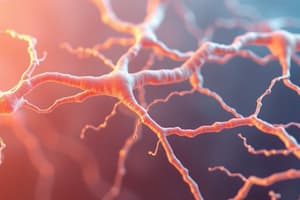Podcast
Questions and Answers
What is a reticular fiber?
What is a reticular fiber?
Reticular fiber
Describe reticular connective tissue.
Describe reticular connective tissue.
Reticular connective tissue is dominated by thin, branching reticular fibers and loose ground substance. The fibers and ground substance are produced by reticular cells, forming an internal scaffolding for organs such as lymph nodes, bone marrow, and the spleen.
What is reticular connective tissue?
What is reticular connective tissue?
Is a fine interlacing network of reticular fibers and reticular cells.
Where is reticular connective tissue located?
Where is reticular connective tissue located?
What is the function of reticular connective tissue?
What is the function of reticular connective tissue?
What is an additional characteristic of reticular tissue?
What is an additional characteristic of reticular tissue?
What type of connective tissue provides the framework for organs such as the spleen and lymph nodes?
What type of connective tissue provides the framework for organs such as the spleen and lymph nodes?
Flashcards are hidden until you start studying
Study Notes
Reticular Connective Tissue Overview
- Comprises thin, branching reticular fibers and loose ground substance.
- Produced by specialized cells known as reticular cells, a type of fibroblast.
Structure
- Characterized by a fine interlacing network of reticular fibers and reticular cells.
- Forms a net-like structure that provides support.
Function
- Serves as an internal scaffolding for organs like lymph nodes, bone marrow, and spleen.
- Supports various cell types, including white blood cells, mast cells, and macrophages.
Locations
- Predominantly found in lymphoid organs such as:
- Lymph nodes
- Bone marrow
- Spleen
Key Characteristics
- Reticular connective tissue is essential for organ framework and immune response support.
- Its network facilitates communication and organization between different cell types within the tissue.
Studying That Suits You
Use AI to generate personalized quizzes and flashcards to suit your learning preferences.




